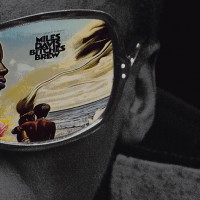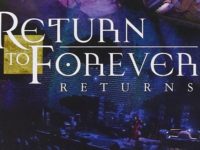Lenny White, drummer with fusion-rock pioneers Return to Forever, discusses how his time with Miles Davis not only touched off a dramatic period of experimentation in jazz, but also helped transform the way White approached reshaping familiar songs into new fusion forms. (That includes a later R&B-infused reimagining of the Beatles’ “Lady Madonna” featuring soul stars like Chaka Khan and the keyboardist from Earth Wind and Fire.)
Learn more about the way Return to Forever quickly rekindled after more than 30 years apart, and how he’s working even now to reformulate a composition from one of their Grammy award-winning projects for RTF’s new tour …
“BITCHES BREW, with Miles Davis (BITCHES BREW, 1970): A centerpiece recording from an experimental jazz-rock double-album that eventually became Miles Davis’ first-ever gold-selling release. The rhythm section on the track featured two drummers (including White), two bassists, two electric piano players and two percussionists — all playing at the same time, in a fiery outburst that owed much to Jimi Hendrix. Together, they set a template for the fusion revolution to come.
LENNY WHITE: The mistake people made was calling it fusion. It was jazz rock. There were elements that were authentic jazz elements and there were authentic rock elements. It was music that was true to both art forms. It wasn’t what fusion became after that; in seven or eight years, that was fusion. Then what you got was a hybrid, music that had licks and attitude that were somewhere between the two. ‘Bitches Brew’ and what bands like Return to Forever, Mahavishnu Orchestra and Weather Report were actually bands that were true to both kinds of music. They were jazz rock bands as opposed to fusion bands. They put that moniker on the musical style because they didn’t know what to call it. It’s interesting being on the front end of something that becomes a paradigm shift like that. It’s so new that nobody understands it — and they don’t know what to call it. So they call it a mixture or a fusion. But it was an art form unto itself.
“SOFISTIFUNK, with Return to Forever (NO MYSTERY, 1975): White’s fun composition, part of RTF’s Grammy-winning fifth album, was built around a repeated synthesizer riff — something that allowed White and Stanley Clarke to build increasingly complex rhythms over the top.
LENNY WHITE: It’s so weird that you mention that song, because (Return to Forever co-founder) Chick (Corea) wants me to do a new arrangement for this new tour — and, honestly, I am so past that. (Laughs.) I want to do something totally different. Maybe I will have to look at that again. I like the rhythm aspect. It’s a good feeling when you’ve done some music that people really hold endearingly. Then you get an opportunity to reinvigorate that music and try to do some different things with is. It’s a good challenge.
[SOMETHING ELSE! INTERVIEW: Lenny White takes us inside the sessions for Miles Davis’ ‘Bitches Brew’ and Freddie Hubbard’s ‘Red Clay,’ then talks more about the newly reunited Return to Forever.]
“OLD WINE, NEW BOTTLES,” with the Manhattan Project (THE MANHATTAN PROJECT, 1990): White’s idea for this project was to add a new fusion sheen to traditional jazz standards, with additional arrangements by Gil Goldstein. Also featured on the date, recorded live at Chelsea Studios in New York, are Clarke, Wayne Shorter and Michel Petrucciani, among others. The album opened with this White composition, which featured some memorable work on the acoustic bass from Clarke.
LENNY WHITE: We were called the children of Miles, and that was appropriate for this project since Miles was a guy who built bridges. He was always able to pick familiar songs and do new things with them. He would take popular music and he had his group play that — and it’s amazing. He makes “Billy Boy” (from 1958’s Milestones) a classic. From there, John Coltrane does “My Favorite Things” (in 1961). This is music taken from the popular music songbook and made into jazz classics by progressive musicians. Miles always had the ability to do that. Being exposed to and having the privilege to play with Miles, those kind of things come with all us now. Chick and Stanley and myself, we have these same qualities in what we try to portray in our music — and then these things begin to happen. You get a rendition looked at through new eyes. You find something in standard form, or a standard song, then flip it and make it different.
“LADY MADONNA,” solo (STREAMLINE 1978) Chaka Khan was the guest vocalist on this very funky redo of a Lennon-McCartney pop classic, which went to No. 4 in the U.S. and No. 1 in England for the Beatles in 1968. Part of White’s fourth studio album, which was produced by Earth Wind and Fire keyboardist Larry Dunn. Marcus Miller is the bassist.
LENNY WHITE: The challenge is what any musician or any artist really wants to have. When the artist is no longer challenging himself, then the art they create becomes mediocre. I’ll never forget it when we did that song, there was a radio station in Pittsburgh that had people called in to vote between the original by the Beatles and the one we did. How could you?! (Laughs.) The Beatles version is sacred music. But the fact that they would do that was special for me. They were giving some credit to what it is that I had done.
“VULCAN WORLDS,” with Return to Forever (RETURNS, 2009): Belying the idea that a decades-long hiatus had slowed the band, Return to Forever hit the road again for a smash reunion tour in 2008, with Stanley Clarke’s space-progressive classic as an explosive highlight. Over 13 minutes, RTF not only reclaimed its mantle as fusion legends but also showed how musically connected the group always was. Round after round of rapturous applause greeted each soloist.
White: What really is always special is when you get an affinity with certain musicians. No matter what kind of music, no matter what you play — it’s special. These situations that you can take advantage of like that, it really makes it that much more special for the people in the audience. Chick and Stanley, I have been playing with these guys for more than 40 years. No matter what kind of music we play, it’s going to be interesting in our own way. It’s not that different getting back together with these guys and playing. We did a whole tour of the world as a trio — an acoustic trio, which we hadn’t done — in 2009. That ups the ante even more. All of those different situations make when we play the electric music that much more special — because of the way we interact.
- Nick DeRiso’s Best of 2015 (Rock + Pop): Death Cab for Cutie, Joe Jackson, Toto + Others - January 18, 2016
- Nick DeRiso’s Best of 2015 (Blues, Jazz + R&B): Boz Scaggs, Gavin Harrison, Alabama Shakes - January 10, 2016
- Nick DeRiso’s Best of 2015 (Reissues + Live): John Oates, Led Zeppelin, Yes, Faces + others - January 7, 2016



